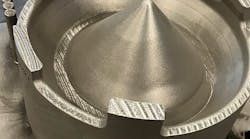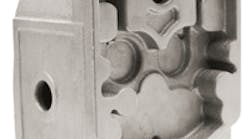Process schematic for Rapid Casting Technology shows how a mold or core is built up in layers. S Print machine provides all necessary functions to carry out RCT.
Rapid Casting Technology (RCT) an application made available recently by ProMetal, a division of The Ex One Co. It enables foundries to produce sand molds and cores directly from CAD files. The technology was developed in Germany and has been available to the North American market for about two years, according to Jeffrey McDaniel, ProMetal’s engineering and project manager.
McDaniel explains that RCT basically is a rapid prototyping process that uses printing technology to build up a shape, either a mold or a core. Working from the CAD files, the process creates “slices” of the required mold or core electronically, then builds the mold or core by “printing” the slices one after another.
According to McDaniel, “The base materials that we use match what foundries use exactly. We use silica sand and furan binding systems.” The significant difference is that no tooling is required to form the mold or core.
The process can be used to produce prototype castings economically and to validate mold designs. It also could be used in certain applications to eliminate coreboxes or to produce especially intricate cores. Some foundries might find it useful to augment traditional processes.
The mold or core produced by RCT can be used for casting aluminum, copper alloys, ductile iron, grey iron, and steel. Magnesium also maybe cast by mixing an inhibitor in with the sand.
The accompanying diagram illustrates the steps for building up the layers (or slices) that form a mold or core:
1. Print — binder is “printed” on a layer of pre-activated sand.
2. New layer — the build platform is lowered by a set increment.
3. Spread — a new layer of premixed sand is spread using a vibrating re-coater system.
4. Repeat — steps 1-3 are repeated until the mold or core is built.
5. Clean and extract — unbound sand is removed effortlessly, using brushes and a vacuum cleaner.
Without the need to produce tooling, the lead time for producing castings from CAD files is drastically reduced. This makes the process attractive for producing castings in short runs or for comparing design variations.
In addition, the process could be used to evaluate various gating and venting systems by working from CAD files detailing the various systems. Throughout this process of working with virtual tooling, the basic casting shape can remain the same, or it can be altered.
ProMetal provides contract services, too, supplying molds, cores, and assistance in building the CAD files. And, the company has the ability to scan a part to develop the required molds and /or cores.
For the truly ambitious metalcasting operation, ProMetal will supply the machinery and supplies needed to operate the technology in-house. The lineup of machines includes the S15, for molds with dimensions up to 5930 28 in.; the S-Print, for molds or cores 29.51515.75 in.; and the SR2, for molds or cores 8108 in. Supplies available include FB101, a furan-resin binder system; FC101, a cleaner for machine maintenance; FS101 and 102, preactivated casting media with standard and coarse grain sizes respectively; and FS103, the sand mix with an inhibitor for use in casting magnesium.











